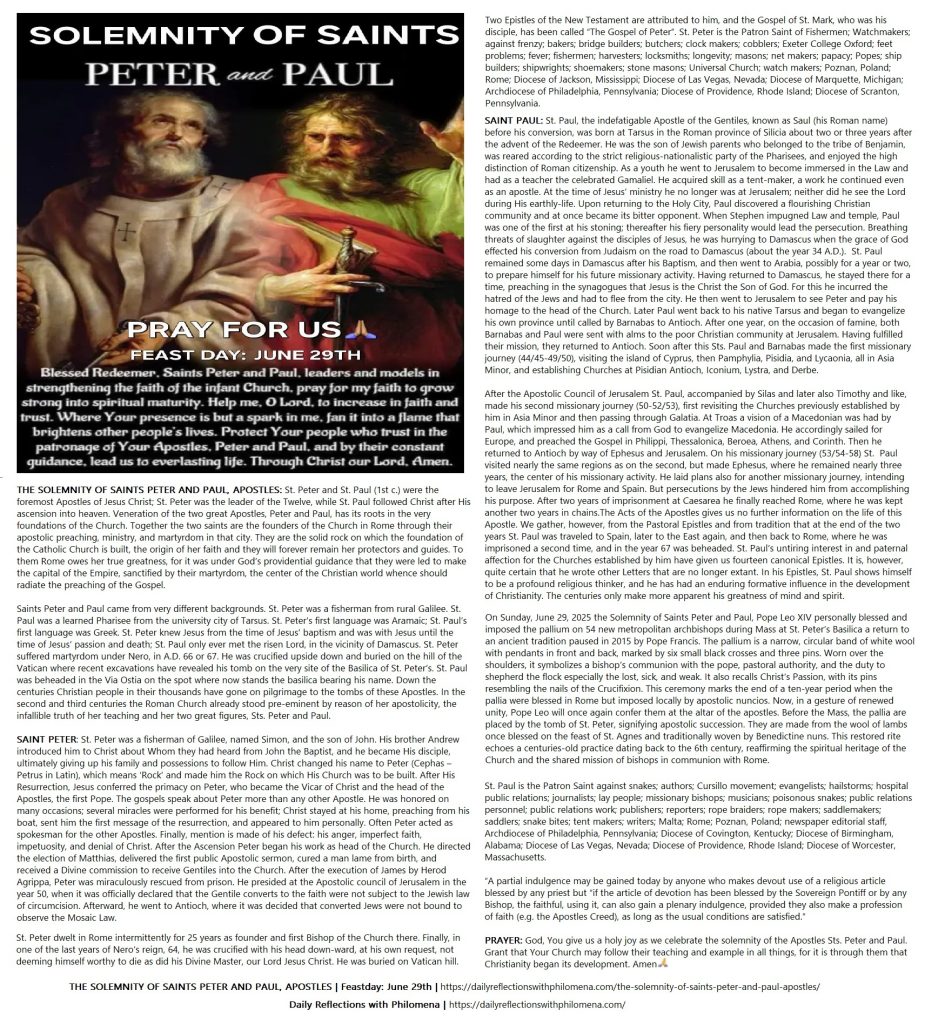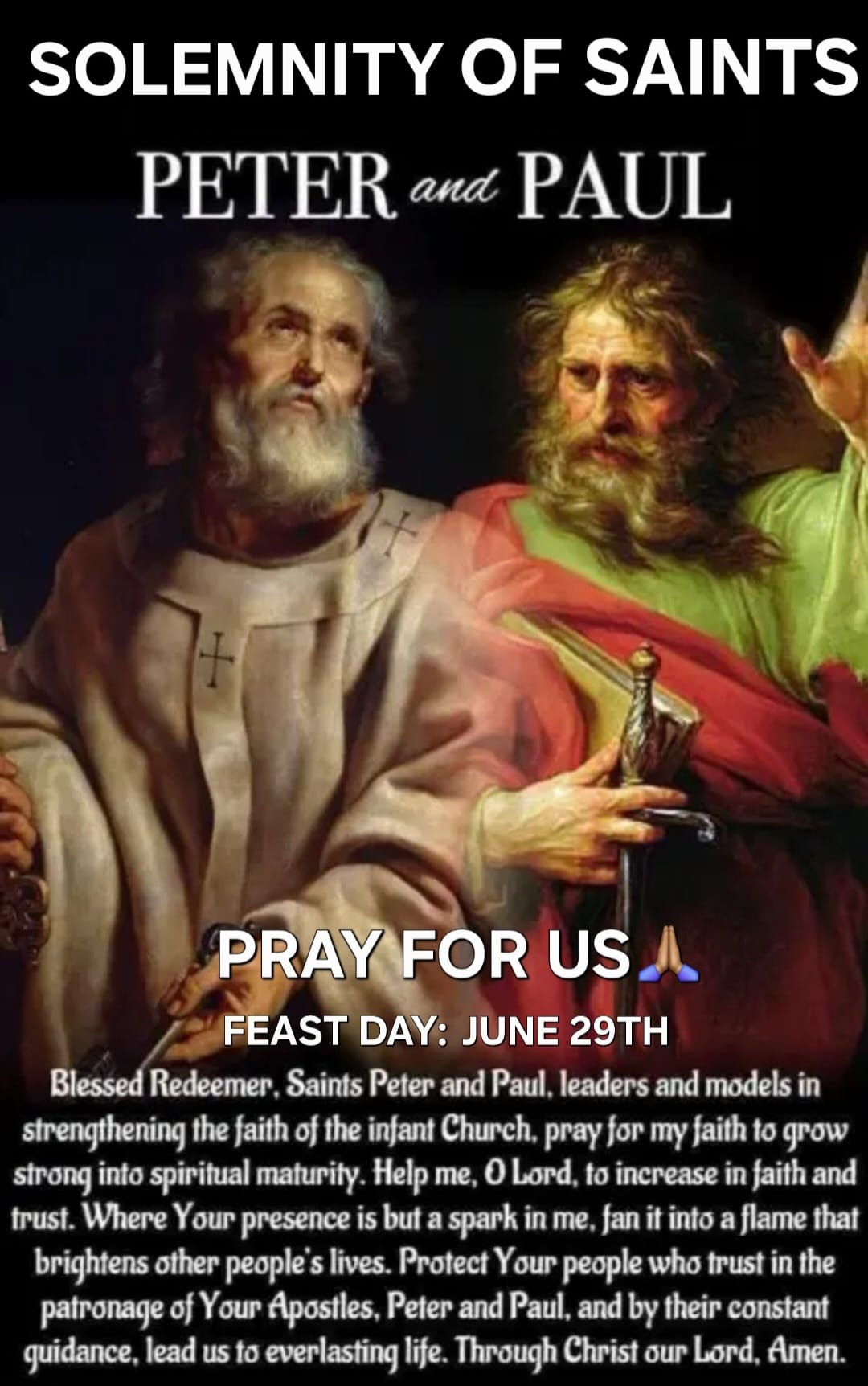
St. Peter and St. Paul (1st c.) were the foremost Apostles of Jesus Christ; St. Peter was the leader of the Twelve, while St. Paul followed Christ after His ascension into heaven. Veneration of the two great Apostles, Peter and Paul, has its roots in the very foundations of the Church. Together the two saints are the founders of the Church in Rome through their apostolic preaching, ministry, and martyrdom in that city. They are the solid rock on which the foundation of the Catholic Church is built, the origin of her faith and they will forever remain her protectors and guides. To them Rome owes her true greatness, for it was under God’s providential guidance that they were led to make the capital of the Empire, sanctified by their martyrdom, the center of the Christian world whence should radiate the preaching of the Gospel.
Saints Peter and Paul came from very different backgrounds. St. Peter was a fisherman from rural Galilee. St. Paul was a learned Pharisee from the university city of Tarsus. St. Peter’s first language was Aramaic; St. Paul’s first language was Greek. St. Peter knew Jesus from the time of Jesus’ baptism and was with Jesus until the time of Jesus’ passion and death; St. Paul only ever met the risen Lord, in the vicinity of Damascus. St. Peter suffered martyrdom under Nero, in A.D. 66 or 67. He was crucified upside down and buried on the hill of the Vatican where recent excavations have revealed his tomb on the very site of the Basilica of St. Peter’s. St. Paul was beheaded in the Via Ostia on the spot where now stands the basilica bearing his name. Down the centuries Christian people in their thousands have gone on pilgrimage to the tombs of these Apostles. In the second and third centuries the Roman Church already stood pre-eminent by reason of her apostolicity, the infallible truth of her teaching and her two great figures, Sts. Peter and Paul.
SAINT PETER: St. Peter was a fisherman of Galilee, named Simon, and the son of John. His brother Andrew introduced him to Christ about Whom they had heard from John the Baptist, and he became His disciple, ultimately giving up his family and possessions to follow Him. Christ changed his name to Peter (Cephas – Petrus in Latin), which means ‘Rock’ and made him the Rock on which His Church was to be built. After His Resurrection, Jesus conferred the primacy on Peter, who became the Vicar of Christ and the head of the Apostles, the first Pope. The gospels speak about Peter more than any other Apostle. He was honored on many occasions; several miracles were performed for his benefit; Christ stayed at his home, preaching from his boat, sent him the first message of the resurrection, and appeared to him personally. Often Peter acted as spokesman for the other Apostles. Finally, mention is made of his defect: his anger, imperfect faith, impetuosity, and denial of Christ. After the Ascension Peter began his work as head of the Church. He directed the election of Matthias, delivered the first public Apostolic sermon, cured a man lame from birth, and received a Divine commission to receive Gentiles into the Church. After the execution of James by Herod Agrippa, Peter was miraculously rescued from prison. He presided at the Apostolic council of Jerusalem in the year 50, when it was officially declared that the Gentile converts to the faith were not subject to the Jewish law of circumcision. Afterward, he went to Antioch, where it was decided that converted Jews were not bound to observe the Mosaic Law.
St. Peter dwelt in Rome intermittently for 25 years as founder and first Bishop of the Church there. Finally, in one of the last years of Nero’s reign, 64, he was crucified with his head down-ward, at his own request, not deeming himself worthy to die as did his Divine Master, our Lord Jesus Christ. He was buried on Vatican hill. Two Epistles of the New Testament are attributed to him, and the Gospel of St. Mark, who was his disciple, has been called “The Gospel of Peter”. St. Peter is the Patron Saint of Fishermen; Watchmakers; against frenzy; bakers; bridge builders; butchers; clock makers; cobblers; Exeter College Oxford; feet problems; fever; fishermen; harvesters; locksmiths; longevity; masons; net makers; papacy; Popes; ship builders; shipwrights; shoemakers; stone masons; Universal Church; watch makers; Poznan, Poland; Rome; Diocese of Jackson, Mississippi; Diocese of Las Vegas, Nevada; Diocese of Marquette, Michigan; Archdiocese of Philadelphia, Pennsylvania; Diocese of Providence, Rhode Island; Diocese of Scranton, Pennsylvania.
SAINT PAUL: St. Paul, the indefatigable Apostle of the Gentiles, known as Saul (his Roman name) before his conversion, was born at Tarsus in the Roman province of Silicia about two or three years after the advent of the Redeemer. He was the son of Jewish parents who belonged to the tribe of Benjamin, was reared according to the strict religious-nationalistic party of the Pharisees, and enjoyed the high distinction of Roman citizenship. As a youth he went to Jerusalem to become immersed in the Law and had as a teacher the celebrated Gamaliel. He acquired skill as a tent-maker, a work he continued even as an apostle. At the time of Jesus’ ministry he no longer was at Jerusalem; neither did he see the Lord during His earthly-life. Upon returning to the Holy City, Paul discovered a flourishing Christian community and at once became its bitter opponent. When Stephen impugned Law and temple, Paul was one of the first at his stoning; thereafter his fiery personality would lead the persecution. Breathing threats of slaughter against the disciples of Jesus, he was hurrying to Damascus when the grace of God effected his conversion from Judaism on the road to Damascus (about the year 34 A.D.). St. Paul remained some days in Damascus after his Baptism, and then went to Arabia, possibly for a year or two, to prepare himself for his future missionary activity. Having returned to Damascus, he stayed there for a time, preaching in the synagogues that Jesus is the Christ the Son of God. For this he incurred the hatred of the Jews and had to flee from the city. He then went to Jerusalem to see Peter and pay his homage to the head of the Church. Later Paul went back to his native Tarsus and began to evangelize his own province until called by Barnabas to Antioch. After one year, on the occasion of famine, both Barnabas and Paul were sent with alms to the poor Christian community at Jerusalem. Having fulfilled their mission, they returned to Antioch. Soon after this Sts. Paul and Barnabas made the first missionary journey (44/45-49/50), visiting the island of Cyprus, then Pamphylia, Pisidia, and Lycaonia, all in Asia Minor, and establishing Churches at Pisidian Antioch, Iconium, Lystra, and Derbe.
After the Apostolic Council of Jerusalem St. Paul, accompanied by Silas and later also Timothy and like, made his second missionary journey (50-52/53), first revisiting the Churches previously established by him in Asia Minor and then passing through Galatia. At Troas a vision of a Macedonian was had by Paul, which impressed him as a call from God to evangelize Macedonia. He accordingly sailed for Europe, and preached the Gospel in Philippi, Thessalonica, Beroea, Athens, and Corinth. Then he returned to Antioch by way of Ephesus and Jerusalem. On his missionary journey (53/54-58) St. Paul visited nearly the same regions as on the second, but made Ephesus, where he remained nearly three years, the center of his missionary activity. He laid plans also for another missionary journey, intending to leave Jerusalem for Rome and Spain. But persecutions by the Jews hindered him from accomplishing his purpose. After two years of imprisonment at Caesarea he finally reached Rome, where he was kept another two years in chains.The Acts of the Apostles gives us no further information on the life of this Apostle. We gather, however, from the Pastoral Epistles and from tradition that at the end of the two years St. Paul was traveled to Spain, later to the East again, and then back to Rome, where he was imprisoned a second time, and in the year 67 was beheaded. St. Paul’s untiring interest in and paternal affection for the Churches established by him have given us fourteen canonical Epistles. It is, however, quite certain that he wrote other Letters that are no longer extant. In his Epistles, St. Paul shows himself to be a profound religious thinker, and he has had an enduring formative influence in the development of Christianity. The centuries only make more apparent his greatness of mind and spirit.
On Sunday, June 29, 2025 the Solemnity of Saints Peter and Paul, Pope Leo XIV personally blessed and imposed the pallium on 54 new metropolitan archbishops during Mass at St. Peter’s Basilica a return to an ancient tradition paused in 2015 by Pope Francis. The pallium is a narrow, circular band of white wool with pendants in front and back, marked by six small black crosses and three pins. Worn over the shoulders, it symbolizes a bishop’s communion with the pope, pastoral authority, and the duty to shepherd the flock especially the lost, sick, and weak. It also recalls Christ’s Passion, with its pins resembling the nails of the Crucifixion. This ceremony marks the end of a ten-year period when the pallia were blessed in Rome but imposed locally by apostolic nuncios. Now, in a gesture of renewed unity, Pope Leo will once again confer them at the altar of the apostles. Before the Mass, the pallia are placed by the tomb of St. Peter, signifying apostolic succession. They are made from the wool of lambs once blessed on the feast of St. Agnes and traditionally woven by Benedictine nuns. This restored rite echoes a centuries-old practice dating back to the 6th century, reaffirming the spiritual heritage of the Church and the shared mission of bishops in communion with Rome.
St. Paul is the Patron Saint against snakes; authors; Cursillo movement; evangelists; hailstorms; hospital public relations; journalists; lay people; missionary bishops; musicians; poisonous snakes; public relations personnel; public relations work; publishers; reporters; rope braiders; rope makers; saddlemakers; saddlers; snake bites; tent makers; writers; Malta; Rome; Poznan, Poland; newspaper editorial staff, Archdiocese of Philadelphia, Pennsylvania; Diocese of Covington, Kentucky; Diocese of Birmingham, Alabama; Diocese of Las Vegas, Nevada; Diocese of Providence, Rhode Island; Diocese of Worcester, Massachusetts.
“A partial indulgence may be gained today by anyone who makes devout use of a religious article blessed by any priest but “if the article of devotion has been blessed by the Sovereign Pontiff or by any Bishop, the faithful, using it, can also gain a plenary indulgence, provided they also make a profession of faith (e.g. the Apostles Creed), as long as the usual conditions are satisfied.”
PRAYER: God, You give us a holy joy as we celebrate the solemnity of the Apostles Sts. Peter and Paul. Grant that Your Church may follow their teaching and example in all things, for it is through them that Christianity began its development. Amen 🙏🏽
THE SOLEMNITY OF SAINTS PETER AND PAUL, APOSTLES | https://dailyreflectionswithphilomena.com/the-solemnity-of-saints-peter-and-paul-apostles/
